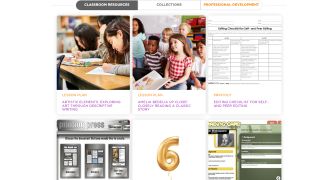ReadWriteThink is an online resource dedicated to helping students with literacy learning.
The free-to-use platform combines lessons, activities, and printable materials for literacy progression.
It has offers a lot of literary expertise and focus, including being created by the National Council of Teachers of English (NCTE), being Common Core-aligned, and having International Reading Association (IRA) standards also.
Read on to find out all you need to know about ReadWriteThink.
- What Is Quizlet And How Can I Teach With It?
- Top Sites and Apps for Math During Remote Learning
- Best Tools for Teachers
What is ReadWriteThink?
ReadWriteThink is a web-based resource center for teachers that aims to help teach literacy to students. The site starts at K and runs right to grade 12 with lesson and unit plans, activities, and more.

So while this is primarily built for teachers, it could also be used by home school providers as a way to supplement learning for students. Since everything is freely available and clearly laid out, it's very easy to use and pick up quickly.
Short of providing the book itself, this resource offers all you could need to stimulate learning and guide you to further teaching surrounding a particular text. Since most of it is also available as print outs, via saved files, it's built for classroom use as well as remote teaching.
How does ReadWriteThink work?
ReadWriteThink is freely available to all and doesn't require you to sign-up for an account or even to put up with ads. The inclusion of lesson plans upfront makes this a great way to inspire teachers on how to think about teaching a lesson around a particular book. It can help remove much the work of that lesson-planning process.

The site is super well organized, which allows you to filter by grade, topic, type, and even learning objectives. Consequently, it's possible for an educator to narrow down the resources to a specific class as well as even to specific individuals or groups within that.
While the lesson plans are very comprehensive and can be printed directly, it's also possible to edit. This allows teachers to personalize plans for a specific lesson or class, or to vary it from year to year.
A section on professional development is aimed at broadening teacher understanding with conventions, specific areas such as picture books, online events, teaching poetry specifically, and more.
What are the best ReadWriteThink features?
ReadWriteThink is superb for lesson planning with minimal effort required. That ability to filter is key here as it makes for specific outputs based on exact needs. The selection of printouts, which are also digital resources, are ideal as a way to work with useful information. From possible research topics on a subject to listening notes and word analysis - there is plenty to expand on any subject from this area.

The preparation section is particularly helpful. This lays out everything step by step. For example, in a Maya Angelou lesson – taught based on the anniversary of her birthday – you're told how to get the book listed so you can plan what to get from the library, given suggested extra reading links, information for students on copyright, plagiarism, and paraphrasing, and then guidance on what to ask students to do before the lesson -- with links to mini lessons and much more.
Essentially this is a follow-the-steps guide that helps to plan very in-depth lessons and courses of lessons, which require very little work on the teacher's part – making this a time-saving resource.
The calendar, mentioned previously, is a particularly great tool for organizing lessons based on individuals' birthdays. Useful for planning ahead, filtering lessons, and perhaps for finding something new that might not have been thought about as a teaching option.
How much does ReadWriteThink cost?
ReadWriteThink is totally free to use. There is no need to sign up, there are no ads, and you're not tracked. Truly a free resource for all to use.
What it doesn't offer is the books it may be talking about. For some cases you'll have links, but in many cases teachers will have to source the books separately. This might require buying books for the class or simply accessing any from the school library -- or using a source such as Storia -- so this can be a truly free way to enhance literacy teaching.
ReadWriteThink best tips and tricks
Birthday build
Build lessons based on famous figures' birthdays and have students who also have that birthday bring something to share with the group or class about that individual, possibly something they have in common, or perhaps very different from them.
Go digital
While there are a lot of printable resources, you can keep everything digital, downloading what you need and working with your online management system. This can make sharing resources with the class, outside of lesson time, easier.
Share
Try sharing your a lesson plan, after editing it, with other teachers and see if they can do the same to you to help develop teaching styles in new ways.

